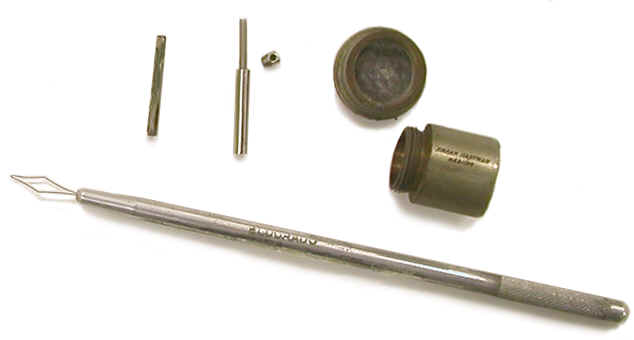Radium Tube, Cell, Container and Threader (ca. 1940s to 1960s)
These items came from a plastic display case of unknown origin. The case contained two small labels that read "Atomic Energy of Canada Limited, Commercial Products Division, Ottawa Canada," but the homemade appearance suggests that the display was not an "official' one. Since the small source container (right side of photo) reads "Frank Hartman Radium," it is possible that it was produced by Hartman, a distributor of radium products who operated out of Philadelphia.

The container is very similar in appearance to one that appears in a catalog of the Radium Chemical Company of Colorado. The one here, 25 mm long and 17 mm in diameter, is smaller than that described in the catalog (55 mm long and 25 mm in diameter). It appears to be nickel plated brass with a lead-lined cap. Why the bottom of the container is not lead-lined is a mystery. Quoting the Radium Chemical Company catalog: "The purpose of this accessory is to afford protection from the radium radiation while carrying the tube. All our radium tubes are regularly delivered in a container of this type."
The solid tube in the upper left was identified as a "cell." A cell is a sealed tube that contained the radium source—it could not be opened. A cell this large (22 mm long, 2 mm diameter) would have been used in a radium tube rather than a needle. "European type" needles and tubes employed cells. "American type" needles and tubes did not use cells—the radium was placed directly inside them. As such, the European type tubes and needles had an extra level of protection from leaks, but an American type needle or tube could hold more radium than a European type one of identical size.
The device in the upper middle of the photograph is a "European type" radium tube (ca. 20 mm long and 3 mm in diameter) that has been opened up so that the cell can be seen. It is identical in appearance to those pictured in a catalog of the X-Ray and Radium Industries Limited, a company headquartered in Toronto, and would have been made of platinum (10% iridium). The catalog claimed that "All the medical radium and associated mineral requirements of the western hemisphere can now be supplied from the Laboratories of X-Ray and Radium Industries, Toronto, Canada."
The long device on the bottom of the photo is a needle threader that was used to insert thread into the eyes of the radium needles or tubes. The only catalog I have that includes such a device is one published by the Canadian Radium and Chemical Corporation. The name "Eldorado," along with "Made in Canada" is stamped on the handle.
References
- Canadian Radium & Chemical Corporation Catalog of Radium and Accessory Equipment for Modern Radium Therapy. Copyright date 1941.
- X-Ray and Radium Industries Limited catalog. No date. ca. 1950s.
- Radium Chemical Company of Colorado catalog. Copyright date 1921.
